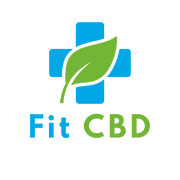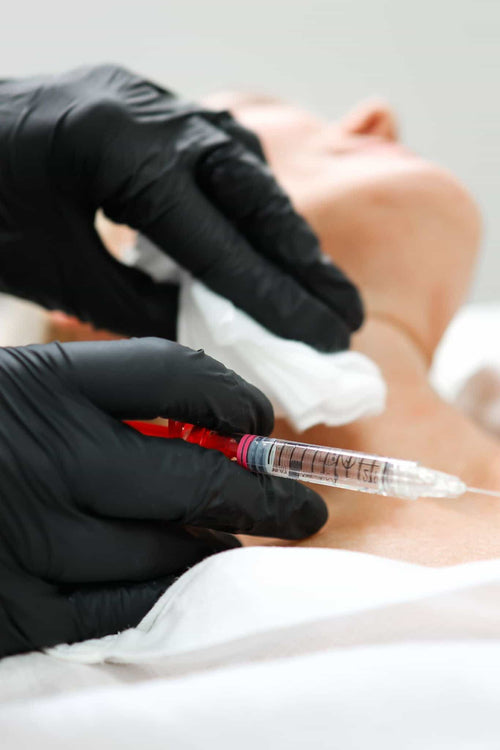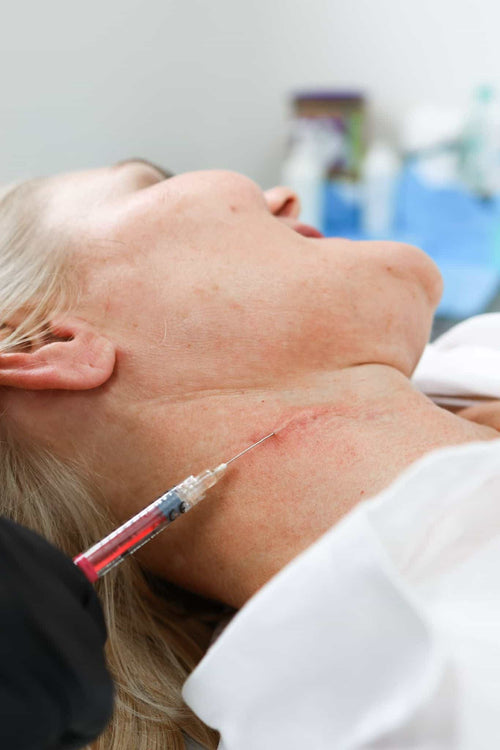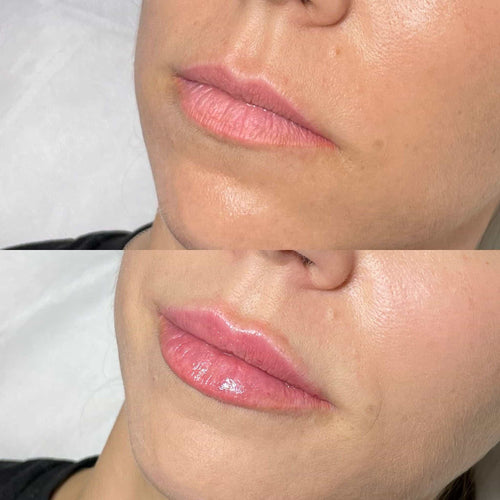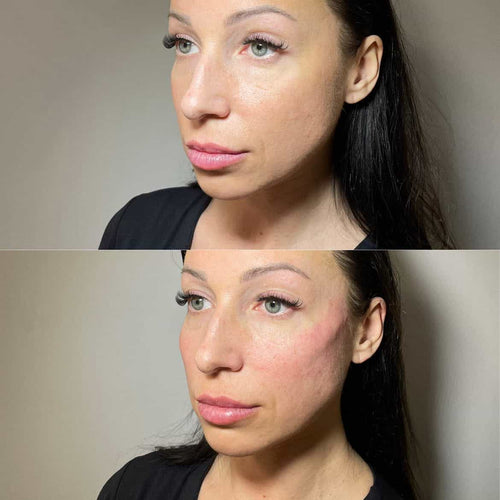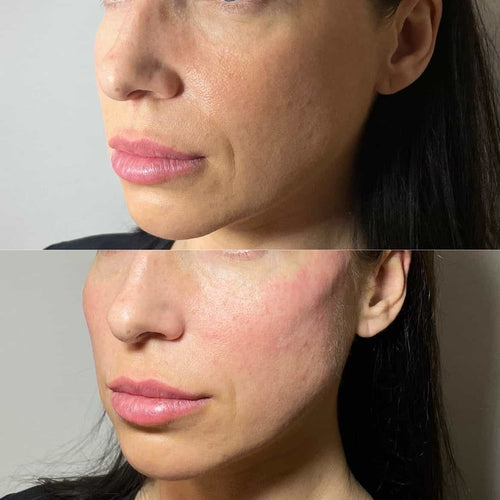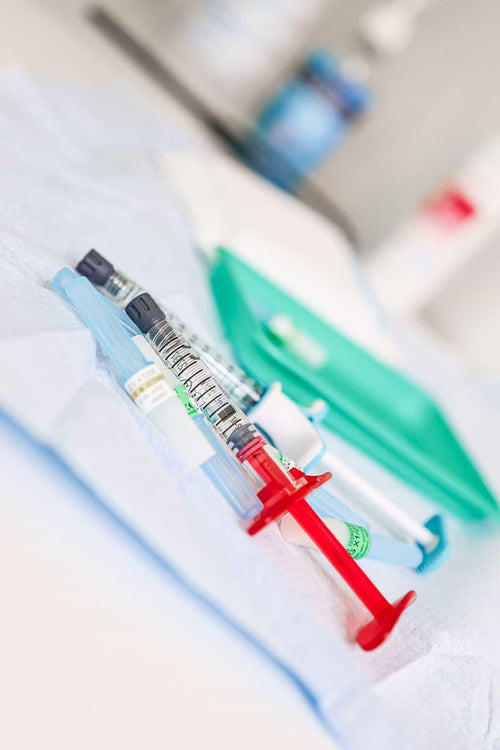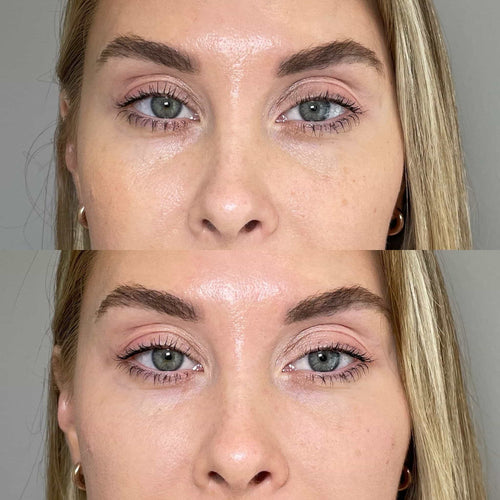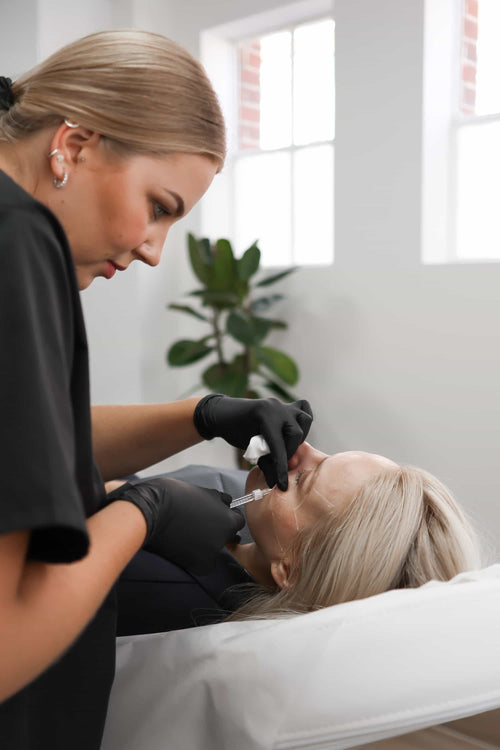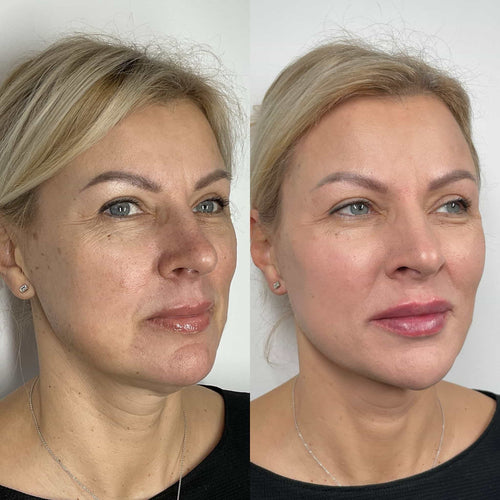Get Your Dermal Filler Consultation with Dr. Laura Geige at It’s Me and You Clinic
Causes of Lip Swelling from Fillers
Lip swelling caused by fillers is a common issue that can be uncomfortable and unsightly. There are several reasons why lip swelling occurs after filler injections.
The primary cause of lip swelling from fillers is the _inflammation_ response of the body to the foreign substance in the dermal layer. When a filler is injected into the skin, the immune system recognizes it as an invader and responds with inflammation, which leads to the release of histamine and other chemical mediators.
These chemicals cause blood vessels to dilate, leading to increased blood flow and swelling in the treated area. The swelling can range from mild to severe and can last for several days or even weeks after the filler injection.
Another cause of lip swelling is the _irritation_ caused by the filler itself. Some fillers, such as those made from hyaluronic acid, can be irritating to the skin, especially if they are not properly prepared or if the patient has a history of allergic reactions.
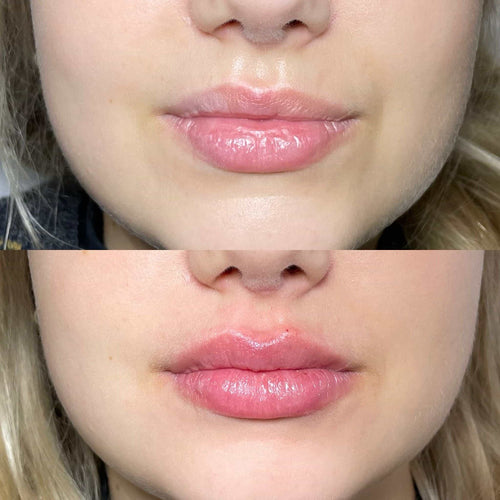
Poor _lymphatic drainage_ is also a significant contributor to lip swelling after filler injections. The lymphatic system plays a crucial role in removing waste and excess fluids from the body, including those that have accumulated around the treated area due to inflammation or irritation.
When the lymphatic vessels are not functioning properly, they are unable to efficiently remove these excess fluids, leading to swelling and edema. This is why it’s essential to follow post-treatment care instructions carefully, which may include massage techniques to stimulate lymphatic drainage and reduce swelling.
Cosmetic and medical factors can also contribute to lip swelling from fillers. For instance, patients with pre-existing skin conditions such as acne or eczema may be more prone to swelling due to increased inflammation. Similarly, the use of certain medications, such as _steroids_ or blood pressure medications, can affect the body’s ability to regulate fluid balance and lead to lip swelling.
Additionally, genetic predisposition can also play a role in lip swelling from fillers. Some individuals may naturally have a more sensitive skin type or be more prone to allergic reactions, which can increase their risk of experiencing lip swelling after filler injections.
In some cases, lip swelling caused by fillers can be a sign of an _allergic reaction_ or _anaphylaxis_. This is a severe and potentially life-threatening condition that requires immediate medical attention. If you experience any of the following symptoms after a filler injection – difficulty breathing, rapid heartbeat, dizziness, or nausea – seek medical help immediately.
To reduce lip swelling from fillers, it’s essential to follow proper post-treatment care instructions and take steps to promote lymphatic drainage, such as massaging the treated area with gentle, circular motions. Maintaining a healthy diet rich in omega-3 fatty acids, vitamin C, and other essential nutrients can also help support skin health and reduce inflammation.
The use of fillers for cosmetic purposes has become increasingly popular, with various types of fillers available to address concerns such as lip augmentation, facial volume enhancement, and skin rejuvenation. However, one common side effect associated with filler injections is lip swelling. This can be a temporary and harmless reaction, but in some cases, it may persist or worsen over time.
There are several causes of lip swelling from fillers, which can be broadly categorized into two groups: acute reactions and chronic conditions.
In the case of acute reactions, lip swelling is often caused by the immune system’s response to the foreign substance in the filler. This reaction may occur due to various factors such as:
– Allergic reactions: Some individuals may be allergic to certain ingredients in fillers, which can trigger an immune response and lead to swelling, redness, and inflammation around the injection site.
– Foreign body reaction: When a filler is injected into the skin, it can cause the body to recognize it as a foreign object, leading to inflammation and swelling in the surrounding tissue.
– Granuloma formation: In some cases, the immune system may form granulomas – small clusters of inflammatory cells – around the filler, which can cause swelling, pain, and redness.
Avoiding these types of reactions requires proper pre- and post-injection care. To minimize the risk of lip swelling from fillers:
– Choose a qualified practitioner: Ensure that your injector is experienced in administering fillers and has a good track record with minimizing side effects.
– Discuss medical history: Inform your practitioner about any medical conditions or allergies you may have, as this can help them choose the most suitable filler for your needs.
– Follow post-injection instructions: Adhere to your practitioner’s recommendations regarding rest, hydration, and pain management after the procedure.
In some cases, lip swelling from fillers may persist or worsen over time. Chronic conditions can be caused by:
– Granuloma formation: As mentioned earlier, granulomas can form around the filler, causing persistent swelling and inflammation.
– Synovitis: Synovitis is an inflammatory condition that affects the lining of joints and tissues. In rare cases, it can cause swelling in areas where fillers have been injected.
– Immunological disorders: Certain autoimmune disorders, such as rheumatoid arthritis or lupus, can increase the risk of lip swelling from fillers due to an overactive immune response.
To address chronic lip swelling caused by fillers:
– Consult a specialist: Seek the advice of a dermatologist or plastic surgeon who specializes in filler management and treatment.
– Remove the filler: In some cases, it may be necessary to remove the offending filler using surgical extraction or laser removal.
– Maintenance treatments: Your practitioner can recommend regular maintenance treatments to maintain optimal fillers results and minimize the risk of lip swelling.
Overall, understanding the causes of lip swelling from fillers is crucial for effective management and treatment. By taking preventative measures and working with a qualified practitioner, you can minimize the risks associated with lip filler injections and enjoy long-lasting, natural-looking results.
Causes of lip swelling from fillers can be attributed to several factors, including *_Infection_* and *_Allergic Reactions_*, which can occur in up to 1-5% of patients.
One of the most common causes of lip swelling from fillers is *_Lymphedema_*, a condition characterized by the abnormal collection of fluid in the body’s lymphatic system. Studies suggest that *_Lymphedema_* can affect up to 10% of patients undergoing *_Hyaluronic Acid_* fillers, which are widely used for cosmetic procedures such as lip augmentation.
Another cause of lip swelling is *_Overfilling_*, where too much filler material is injected into the lip area. This can lead to an inflammatory response and swelling in the affected area.
A *_Poor Injection Technique_* by the practitioner can also cause lip swelling from fillers. If the filler material is not injected correctly, it can cause bleeding, inflammation, or other reactions that lead to swelling.
Using *_Low-Quality Filler Material_* or products that contain impurities can increase the risk of lip swelling from fillers. Some fillers may contain foreign substances or have not been properly tested for safety and efficacy.
A *_Pre-existing Medical Condition_*, such as eczema, psoriasis, or rosacea, can also contribute to lip swelling after filler injection.
_*Hormonal Changes_* during pregnancy or menopause can affect the body’s natural fluid balance, leading to swelling in the face and lips after filler procedures.
Smoking is another factor that can increase the risk of lip swelling from fillers. Smoking damages blood vessels and impairs circulation, which can lead to decreased healing times and increased swelling.
A *_Sudden Change in Environment_* or climate can also cause temporary lip swelling due to changes in temperature and humidity levels.
It is essential to note that lip swelling from fillers can be a sign of a more serious condition, such as *_Necrotizing Lipodystrophy_*, which is a rare but potentially life-threatening complication. If you experience persistent or severe swelling, redness, or other symptoms after a filler procedure, it is crucial to seek medical attention immediately.
By understanding the potential causes of lip swelling from fillers and taking steps to minimize risks, individuals can reduce their chance of experiencing this common side effect and enjoy a smoother, more natural-looking result from their cosmetic procedures.
The causes of lip swelling from fillers are multifaceted and can be attributed to various factors, including the type of filler used, individual patient sensitivity, and proper post-injection care.
One of the primary causes of lip swelling from fillers is the introduction of a foreign substance into the body. Fillers, such as hyaluronic acid (HA) or collagen, are injected into the lips to add volume and enhance facial features. However, the body may react to the presence of these substances, leading to inflammation and swelling.
Another cause of lip swelling from fillers is the injection technique itself. If the filler is injected too deeply or aggressively, it can cause the surrounding tissue to become irritated, leading to swelling and bruising.
The type of filler used can also play a significant role in causing lip swelling. Some fillers, such as HA, are more likely to cause inflammation and swelling due to their composition and properties. In contrast, other fillers, such as collagen or poly-L-lactic acid, may be less likely to cause swelling.
Schedule Your Dermal Filler Appointment at It’s Me and You Clinic with Dr. Laura Geige
Individual patient sensitivity is another factor that can contribute to lip swelling from fillers. Some people may be more prone to allergic reactions or sensitivities to certain substances, which can lead to increased inflammation and swelling.
The way the filler is injected can also affect the likelihood of lip swelling. Injecting the filler too close to the surface of the skin can cause irritation and inflammation, leading to swelling and bruising.
Furthermore, the technique used to massage out excess filler from the lips can also contribute to lip swelling. If not done properly, this process can cause micro-trauma to the tissue, leading to inflammation and swelling.
Proper drainage techniques after filler injections are crucial in minimizing the risk of lip swelling. This involves gently squeezing out excess filler from the lips using a sterile needle or cannula, followed by gentle massage to help distribute any remaining filler evenly throughout the area.
The University of California, Los Angeles (UCLA) researchers recommend that patients follow proper drainage techniques after filler injections, including:
1. Applying gentle pressure to the treated area with a cold compress or an ice pack wrapped in a cloth for 5-10 minutes at a time.
2. Massaging the treated area gently with your fingertips in a circular motion for 5-10 seconds at a time, followed by a brief pause.
3. Repeating this process several times to help distribute any remaining filler and minimize swelling.
4. Avoiding strenuous activities or exercise for the first 24 hours after treatment.
5. Applying a topical anesthetic cream or ointment, such as lidocaine or benzocaine, to the treated area to help reduce pain and discomfort.
By following these steps and taking proper care of the treated area, patients can minimize their risk of lip swelling from fillers and enjoy optimal results from their treatment.
Prevention and Aftercare Techniques
Surgical precautions are essential to minimize the risk of complications and ensure a smooth recovery after lip filler procedures.
Before undergoing any lip filler treatment, it’s crucial to discuss your medical history and any allergies you may have with your doctor or dermatologist. This includes medications you’re currently taking, as well as any previous surgeries or treatments that may affect the outcome of the procedure.
- Medications such as blood thinners, aspirin, and ibuprofen should be stopped at least one week before the treatment to prevent bruising and bleeding complications.
- Ace inhibitors and NSAIDs should also be avoided for a certain period prior to the procedure, as they can increase the risk of bruising and swelling.
- Smokers may need to wait longer to undergo lip filler treatments due to their increased risk of bleeding and complications.
Aftercare techniques are vital in reducing lip swelling from fillers. Here are some tips:
- Apply ice packs: Applying an ice pack or a cold compress to the treated area can help reduce inflammation and swelling. Wrap the ice pack in a cloth to avoid direct contact with the skin.
- Massage gently: Gentle massage can help promote blood flow and break down the filler material. Use your fingers to massage the area, but avoid over-massaging, which can lead to further irritation.
- Avoid strenuous activities: For a few days after the treatment, try to minimize physical activity or exercise that may cause swelling or bruising.
- Avoid heat and sun exposure: Heat from saunas, hot tubs, and excessive sun exposure can increase blood flow to the treated area, leading to swelling. Wear sunscreen with at least SPF 30 to protect the skin.
- Use gentle skincare products: Choose fragrance-free, hypoallergenic skincare products that are gentle on the skin. Avoid using harsh or abrasive products that can irritate the skin.
Anti-edema medication can also be used to reduce swelling and inflammation after lip filler treatments. Here are some options:
- Cortisone injections: Cortisone injections can help reduce inflammation and swelling by injecting the corticosteroid directly into the affected area.
- Oral anti-inflammatory medications: Over-the-counter or prescription oral medications such as ibuprofen, naproxen, or prednisone can be used to reduce inflammation and swelling.
- Topical creams and ointments: Topical creams or ointments containing ingredients like arnica, peptides, or vitamin K can help reduce inflammation and promote healing.
Edema patches are also available as a home treatment to help reduce swelling. These patches work by constricting blood vessels and reducing fluid accumulation in the affected area.
The type of filler used can also impact the risk of edema and swelling. For example:
- Hyaluronic acid fillers: These fillers are generally well-tolerated and cause minimal side effects, including edema.
- Calcium hydroxylapatite fillers: These fillers can cause more significant side effects, including swelling and inflammation, especially in patients with sensitive skin.
- Poly-L-lactic acid (PLLA) fillers: These fillers are gradually absorbed by the body and may cause some initial swelling, but this usually subsides within a few days.
It’s essential to note that everyone’s response to lip filler treatments is different, and some people may experience more significant side effects than others. Be sure to follow your doctor or dermatologist’s aftercare instructions carefully to minimize the risk of complications.
Lidocaine is a common topical anesthetic used by surgeons to numb the skin and reduce swelling during filler procedures.
The numbing agent works by blocking the nerve signals that transmit pain signals to the brain, allowing the surgeon to perform the procedure with minimal discomfort for the patient.
In addition to lidocaine, other numbing agents such as benzocaine or tetracaine may also be used depending on the location and type of filler being administered.
The numbing agent is typically applied topically to the skin before the procedure, allowing it to take effect before the filler is injected.
Another technique used to reduce swelling is to use a smaller needle or a multi-tip cannula, which can help to minimize tissue trauma and subsequent inflammation.
Surgery may also use lidocaine to reduce the amount of swelling in the surrounding area, allowing for faster recovery times and reduced bruising.
Book a Dermal Filler Consultation at It’s Me and You Clinic with Dr. Laura Geige
Some surgeons may also use ice packs or cold compresses to reduce swelling after a procedure, applying them to the area for 10-15 minutes at a time as needed.
Aromatherapy oils such as lavender or peppermint may be used topically to help reduce swelling and promote relaxation.
Topical arnica gel or cream has also been shown to reduce inflammation and swelling after filler procedures, and can be applied to the area several times a day for optimal results.
In addition to these techniques, it is also recommended that patients follow post-operative instructions carefully, such as applying cold compresses, elevating their head above heart level, and avoiding strenuous activities for several days after treatment.
A well-structured aftercare routine can help to reduce swelling, promote healing, and ensure the best possible results from filler procedures.
It is also essential to follow any specific aftercare instructions provided by your surgeon or medical professional, as they will be able to provide personalized advice based on your individual needs and the type of procedure you underwent.
To prevent lip swelling from filler, it’s essential to understand the causes and take preventive measures.
- Avoiding the use of anti-inflammatory medications, such as ibuprofen or aspirin, in the weeks leading up to the procedure can help reduce the risk of swelling.
- Staying hydrated by drinking plenty of water before and after the procedure can also contribute to reduced swelling.
- Using cold compresses or ice packs on the lips before and after the injection can help constrict blood vessels and reduce inflammation.
Research suggests that administering antiedema medication, such as prednisone, may be beneficial in preventing lip swelling in patients at risk. Prednisone is a corticosteroid medication that helps to reduce inflammation and swelling by decreasing the production of histamine, a chemical mediator released during an allergic reaction.
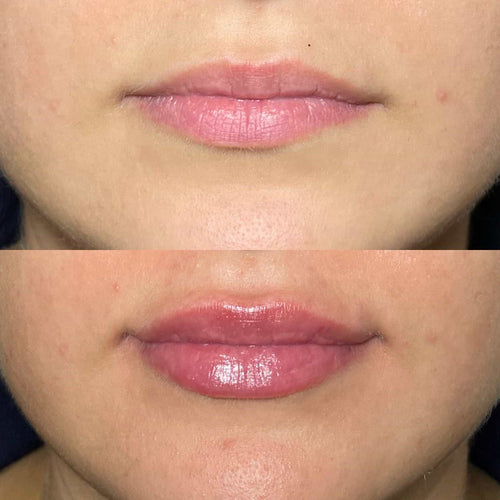
The recommended dosage for prednisone varies depending on individual circumstances, but typically ranges from 5-20 milligrams per day, taken in two or three divided doses. It’s essential to follow the specific instructions provided by your doctor or healthcare professional when using this medication.
Additionally, aftercare techniques play a crucial role in reducing lip swelling and promoting optimal healing. Here are some techniques that may help:
- Rest and relaxation: Avoid strenuous activities, such as exercise or heavy lifting, for at least 24 hours after the procedure to minimize blood flow and reduce inflammation.
- Soothing lip balms: Apply a gentle, fragrance-free lip balm to keep your lips moisturized and comfortable. Look for products containing ingredients like hyaluronic acid, beeswax, or coconut oil.
- Compression bandages: Applying compression bandages to the area can help reduce swelling by constricting blood vessels.
Avoid touching or rubbing your lips excessively, as this can cause further irritation and inflammation. Gently pat the area dry with a clean towel after washing your face, and avoid using harsh skincare products that may contain fragrances or exfoliating agents.
It’s also essential to follow up with your doctor or healthcare professional for post-procedure care instructions. They may prescribe antibiotics or recommend additional treatments to promote healing and minimize the risk of complications.
In general, it’s crucial to be patient and allow your body time to heal after a lip filler procedure. Lip swelling is usually temporary and should resolve on its own within a few days. If you experience persistent or severe swelling, redness, or other concerning symptoms, seek medical attention immediately.
Home Remedies and Treatment Options
$100 million people worldwide undergo cosmetic fillers every year, but one of the most common side effects is lip swelling.
Lip swelling after filler injections can be caused by a range of factors, including overfilling, incorrect needle placement, or an allergic reaction to the ingredients in the filler.
Avoid licking your lips or biting on them as this can cause further irritation and delay healing. This is because the oils from your saliva can spread the filler material into surrounding tissue and exacerbate swelling.
- Apply a cold compress to reduce swelling: Wrap an ice pack or even a bag of frozen peas in a cloth and apply it to the affected area for 10-15 minutes, several times a day. This will help to constrict blood vessels and reduce inflammation.
- Use a topical ointment to soothe your lips: Apply a small amount of petroleum jelly or coconut oil to your swollen lips several times a day. These oils can help to moisturize and protect the skin, reducing irritation and inflammation.
- Massage your lips gently: Use a gentle circular motion with your fingertips to massage your lips and surrounding tissue. This can help to break up any clumps of filler material that may be causing swelling and promote healing.
Dietary changes can also play a role in reducing lip swelling after filler injections. Here are some tips:
- Stay hydrated: Drink plenty of water to help flush out toxins and keep your skin hydrated.
- Avoid spicy or acidic foods: These types of food can irritate the skin and worsen inflammation, making lip swelling worse.
- Incorporate anti-inflammatory foods into your diet: Foods rich in omega-3 fatty acids, such as salmon and walnuts, and turmeric, a spice that has potent anti-inflammatory properties, may help to reduce swelling.
Topical treatments can also be effective in reducing lip swelling after filler injections. Some popular options include:
- Aloe vera gel: Apply a small amount of pure aloe vera gel to your lips several times a day to help soothe and calm the skin.
- Tea tree oil: Mix a few drops of tea tree oil with a carrier oil, such as coconut or olive oil, and apply it to your lips using a cotton swab. This can help to reduce inflammation and fight off infection.
- Vitamin E oil: Apply a small amount of vitamin E oil to your lips several times a day to help promote healing and reduce swelling.
In some cases, lip swelling may be caused by an allergic reaction or other underlying medical condition. If you experience any of the following symptoms, seek medical attention:
- Severe swelling that lasts for more than a week
- Painful or tender lips
- Difficulty speaking or swallowing
- Fever or redness around the injection site
- Increased sensitivity to light
It’s also important to note that some people may experience more severe reactions to fillers, including anaphylaxis. If you experience any symptoms of an allergic reaction after a filler injection, such as difficulty breathing or swallowing, seek medical attention immediately.
Increasing sodium intake can be a helpful remedy for reducing swelling in some individuals, particularly those who experience water retention due to hormonal fluctuations or menopause. However, it’s essential to note that this approach may not work for everyone, and excessive sodium consumption can lead to other health issues.
Avoiding salt altogether may worsen edema in some cases, as sodium helps regulate fluid balance in the body. Reducing salt intake may be more beneficial than avoiding it entirely, especially during the initial stages of recovery after a lip fillers treatment. A low-sodium diet can help minimize swelling and reduce inflammation.
Here are some additional home remedies that may aid in reducing lip swelling from filler:
- Ice packs: Applying an ice pack to the affected area can help reduce swelling and ease discomfort. Wrap an ice cube or a bag of frozen peas in a cloth to protect your skin from direct contact with the cold.
- Elevate your head: Sleeping with an extra pillow under your head can help minimize swelling by reducing fluid accumulation in the face.
- Cold compress: A cold, damp washcloth applied to the affected area can also help reduce swelling and ease pain.
- Stay hydrated: Drinking plenty of water can help flush out toxins and reduce swelling. Aim for at least eight glasses of water a day.
Other non-pharmacological treatments that may help alleviate lip swelling from filler include:
- Hyaluronic acid injections: In some cases, additional hyaluronic acid injections can be administered to the treated area to help replenish lost volume and reduce swelling.
- Massage therapy: Gently massaging the affected area with a gentle circular motion can help break down excess fluid and promote lymphatic drainage.
- Topical creams: Applying topical creams or gels containing ingredients like arnica, witch hazel, or caffeine can help reduce inflammation and swelling.
Avoid using the following remedies, as they may exacerbate lip swelling from filler:
- Salt and sugar scrubs: Avoid using exfoliating products that contain salt, sugar, or other harsh ingredients that can further irritate the skin.
- Hot water bottles: Applying a hot water bottle to the affected area can increase blood flow, which may worsen swelling.
- Astringent toners: Using astringent toners containing witch hazel or other astringent ingredients can dry out the skin and worsen lip swelling.
It’s essential to follow your doctor’s advice regarding post-treatment care and to attend follow-up appointments to ensure proper healing and minimize complications. With patience, self-care, and the right remedies, you can help reduce lip swelling from filler and achieve a smooth, natural-looking result.
Cold compresses applied directly to the affected area have been found to be an effective way to reduce lip swelling caused by filler injections.
The cold temperature helps to constrict blood vessels, which in turn reduces inflammation and swelling.
Another option is to use topical creams or ointments containing arnica, a natural anti-inflammatory agent that has been shown to reduce swelling and pain after cosmetic procedures.
A study published by Harvard Health Publishing found that applying cold compresses or topical creams containing arnica can alleviate lip swelling caused by filler injections.
The arnica cream or gel is typically applied to the affected area several times a day, as directed by a healthcare professional.
It’s also recommended to avoid licking or sucking on the swollen lip, as this can exacerbate the problem and prolong healing time.
Another home remedy for reducing lip swelling from filler injections is to try elevating the head of the bed by at least six inches at night.
This simple trick can help reduce swelling by allowing gravity to work in your favor and prevent fluid from accumulating in the face.
A diet rich in omega-3 fatty acids, which are found in foods such as salmon and walnuts, may also help reduce inflammation and alleviate lip swelling after filler injections.
Other natural remedies that may be helpful in reducing lip swelling include tea bags soaked in cold water or cooled chamomile compresses applied to the affected area.
It’s worth noting that while these home remedies can provide relief from lip swelling, they should not be relied upon as the sole treatment for filler injection complications.
A healthcare professional should always be consulted if symptoms persist or worsen over time.
In some cases, more aggressive treatments such as steroid injections or laser therapy may be necessary to resolve persistent lip swelling caused by filler injections.
It’s also important to follow post-treatment instructions provided by the healthcare professional administering the filler injection, including any specific care or follow-up procedures required.
Additionally, avoiding strenuous activities and taking regular breaks to rest can help reduce lip swelling and promote healing after filler injections.
A well-planned skincare routine that includes gentle exfoliation and moisturization can also help minimize lip swelling and promote a healthy appearance after filler injections.
By combining these home remedies with professional medical treatment, individuals can take an effective approach to reducing lip swelling caused by filler injections and promoting optimal healing.
Read more about Arielle Likes to Cook here. Read more about Kurious Kittens here. Read more about Melissa J Design here. Read more about Melissa Neufeld here. Read more about Pinnacle Wellbeing Media here.
